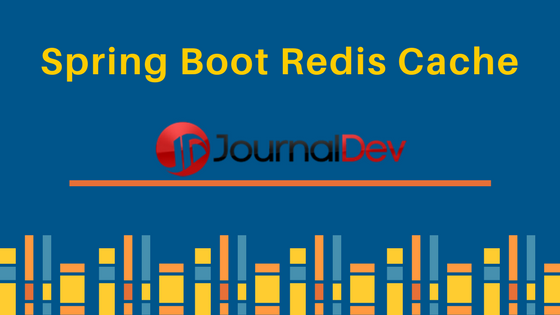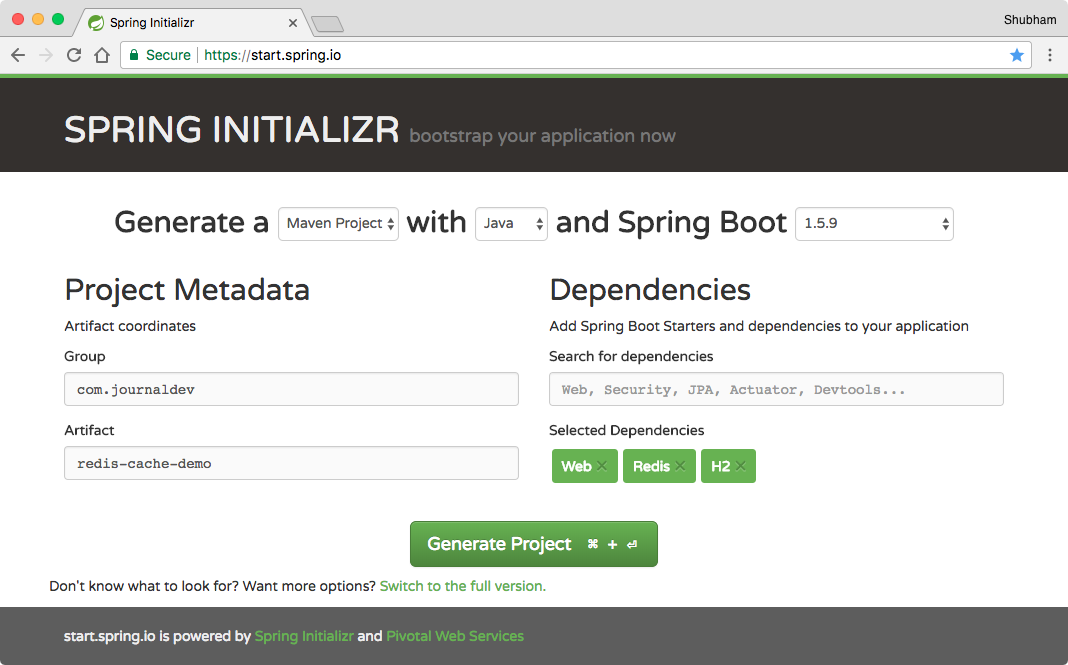Spring Boot Redis缓存
 在本文中,我们将设置一个简单的Spring Boot应用程序,并将其与Redis缓存集成。虽然Redis是一个开源的内存数据结构存储,用作数据库、缓存和消息代理,但本课程将仅演示缓存集成。我们将使用Spring Initializr工具快速设置项目。
在本文中,我们将设置一个简单的Spring Boot应用程序,并将其与Redis缓存集成。虽然Redis是一个开源的内存数据结构存储,用作数据库、缓存和消息代理,但本课程将仅演示缓存集成。我们将使用Spring Initializr工具快速设置项目。
Spring Boot Redis项目设置
我们将使用Spring Initializr工具快速设置项目。我们将使用如下所示的3个依赖项: 下载项目并解压缩。我们使用了H2数据库依赖项,因为我们将使用一个嵌入式数据库,该数据库在应用程序停止后将丢失所有数据。
下载项目并解压缩。我们使用了H2数据库依赖项,因为我们将使用一个嵌入式数据库,该数据库在应用程序停止后将丢失所有数据。
Spring Boot Redis Cache Maven Dependencies
尽管我们已经使用工具完成了设置,如果你想手动设置,我们在这个项目中使用了Maven构建系统,以下是我们使用的依赖关系:
<parent>
<groupId>org.springframework.boot</groupId>
<artifactId>spring-boot-starter-parent</artifactId>
<version>1.5.9.RELEASE</version>
<relativePath/> <!-- lookup parent from repository -->
</parent>
<properties>
<project.build.sourceEncoding>UTF-8</project.build.sourceEncoding>
<project.reporting.outputEncoding>UTF-8</project.reporting.outputEncoding>
<java.version>1.8</java.version>
</properties>
<dependencies>
<dependency>
<groupId>org.springframework.boot</groupId>
<artifactId>spring-boot-starter-data-redis</artifactId>
</dependency>
<dependency>
<groupId>org.springframework.boot</groupId>
<artifactId>spring-boot-starter-web</artifactId>
</dependency>
<dependency>
<groupId>org.springframework.boot</groupId>
<artifactId>spring-boot-starter-test</artifactId>
<scope>test</scope>
</dependency>
<!-- for JPA support -->
<dependency>
<groupId>org.springframework.boot</groupId>
<artifactId>spring-boot-starter-data-jpa</artifactId>
</dependency>
<!-- for embedded database support -->
<dependency>
<groupId>com.h2database</groupId>
<artifactId>h2</artifactId>
<scope>runtime</scope>
</dependency>
</dependencies>
<build>
<plugins>
<plugin>
<groupId>org.springframework.boot</groupId>
<artifactId>spring-boot-maven-plugin</artifactId>
</plugin>
</plugins>
</build>
确保从中央仓库使用Spring Boot的稳定版本。
定义模型
为了将对象保存到Redis数据库中,我们定义了一个具有基本字段的Person模型对象:
package com.journaldev.rediscachedemo;
import javax.persistence.*;
import java.io.Serializable;
@Entity
public class User implements Serializable {
private static final long serialVersionUID = 7156526077883281623L;
@Id
@SequenceGenerator(name = "SEQ_GEN", sequenceName = "SEQ_USER", allocationSize = 1)
@GeneratedValue(strategy = GenerationType.SEQUENCE, generator = "SEQ_GEN")
private Long id;
private String name;
private long followers;
public User() {
}
public User(String name, long followers) {
this.name = name;
this.followers = followers;
}
//标准的getter和setter
@Override
public String toString() {
return String.format("User{id=%d, name='%s', followers=%d}", id, name, followers);
}
}
这是一个带有getter和setter的标准POJO。
配置Redis缓存
使用Spring Boot和已经在Maven中工作的所需依赖,我们可以在application.properties文件中仅用三行配置本地Redis实例:
# Redis配置
spring.cache.type=redis
spring.redis.host=localhost
spring.redis.port=6379
还要在Spring Boot主类上使用@EnableCaching注解:
package com.journaldev.rediscachedemo;
import org.slf4j.Logger;
import org.slf4j.LoggerFactory;
import org.springframework.beans.factory.annotation.Autowired;
import org.springframework.boot.CommandLineRunner;
import org.springframework.boot.SpringApplication;
import org.springframework.boot.autoconfigure.SpringBootApplication;
import org.springframework.cache.annotation.EnableCaching;
@SpringBootApplication
@EnableCaching
public class Application implements CommandLineRunner {
private final Logger LOG = LoggerFactory.getLogger(getClass());
private final UserRepository userRepository;
@Autowired
public Application(UserRepository userRepository) {
this.userRepository = userRepository;
}
public static void main(String[] args) {
SpringApplication.run(Application.class, args);
}
@Override
public void run(String... strings) {
//在这里填充嵌入式数据库
LOG.info("Saving users. Current user count is {}.", userRepository.count());
User shubham = new User("Shubham", 2000);
User pankaj = new User("Pankaj", 29000);
User lewis = new User("Lewis", 550);
userRepository.save(shubham);
userRepository.save(pankaj);
userRepository.save(lewis);
LOG.info("Done saving users. Data: {}.", userRepository.findAll());
}
}
我们已经添加了一个CommandLineRunner,因为我们希望在嵌入式H2数据库中填充一些示例数据。
定义存储库
在展示Redis的工作方式之前,我们将仅定义一个与JPA相关功能的存储库:
package com.journaldev.rediscachedemo;
import org.springframework.data.jpa.repository.JpaRepository;
import org.springframework.stereotype.Repository;
@Repository
public interface UserRepository extends JpaRepository { }
目前它没有任何方法调用,因为我们不需要任何方法。
定义控制器
控制器是调用Redis缓存执行操作的地方。实际上,这是这样做的最佳地方,因为作为与之直接关联的缓存,请求甚至不必进入服务代码等待缓存结果。以下是控制器的框架:
package com.journaldev.rediscachedemo;
import org.slf4j.Logger;
import org.slf4j.LoggerFactory;
import org.springframework.beans.factory.annotation.Autowired;
import org.springframework.cache.annotation.CacheEvict;
import org.springframework.cache.annotation.CachePut;
import org.springframework.cache.annotation.Cacheable;
import org.springframework.web.bind.annotation.*;
@RestController
public class UserController {
private final Logger LOG = LoggerFactory.getLogger(getClass());
private final UserRepository userRepository;
@Autowired
public UserController(UserRepository userRepository) {
this.userRepository = userRepository;
}
...
}
现在,要将某些内容放入缓存中,我们使用@Cacheable注解:
@Cacheable(value = "users", key = "#userId", unless = "#result.followers < 12000")
@RequestMapping(value = "/{userId}", method = RequestMethod.GET)
public User getUser(@PathVariable String userId) {
LOG.info("Getting user with ID {}.", userId);
return userRepository.findOne(Long.valueOf(userId));
}
在上面的映射中,getUser方法将把一个人放入名为’users’的缓存中,通过’userId’键标识该人,并且只会存储关注者超过12000的用户。这确保了缓存中填充了那些非常受欢迎且经常被查询的用户。此外,我们在API调用中故意添加了一个日志语句。让我们此刻从Postman中进行一些API调用。这些是我们进行的调用:
localhost:8090/1
localhost:8090/1
localhost:8090/2
localhost:8090/2
如果我们注意日志,它们将如下所示:
... : Getting user with ID 1.
... : Getting user with ID 1.
... : Getting user with ID 2.
注意到了吗?我们进行了四次API调用,但只有三个日志记录存在。这是因为ID为2的用户有29000个关注者,所以其数据已缓存。这意味着当对其进行API调用时,数据是从缓存中返回的,而不是为此进行数据库调用!
更新缓存
缓存值在其实际对象值更新时也应该更新。这可以使用@CachePut注释来实现:
@CachePut(value = "users", key = "#user.id")
@PutMapping("/update")
public User updatePersonByID(@RequestBody User user) {
userRepository.save(user);
return user;
}
通过这个,一个人再次通过他的ID来识别,并用结果进行更新。
清除缓存
如果要从实际数据库中删除一些数据,那么将它们保留在缓存中就没有意义了。我们可以使用@CacheEvict注释来清除缓存数据:
@CacheEvict(value = "users", allEntries=true)
@DeleteMapping("/{id}")
public void deleteUserByID(@PathVariable Long id) {
LOG.info("deleting person with id {}", id);
userRepository.delete(id);
}
在最后的映射中,我们只是驱逐了缓存条目,没有做其他事情。
运行Spring Boot Redis缓存应用程序
我们可以通过使用一个简单的命令来运行这个应用程序:
mvn spring-boot:run
Redis缓存限制
虽然Redis非常快,但在64位系统上存储任意数量的数据仍然没有限制。在32位系统上,它只能存储3GB的数据。更多的可用内存可能会导致更高的命中率,但是一旦Redis占用了过多内存,这种情况就会停止。当缓存大小达到内存限制时,旧数据将被删除以为新数据腾出空间。
总结
在这节课上,我们了解了Redis缓存提供的强大功能,以及如何在Spring Boot中进行最小而又强大的配置。请随时在下方留言。
Source:
https://www.digitalocean.com/community/tutorials/spring-boot-redis-cache













